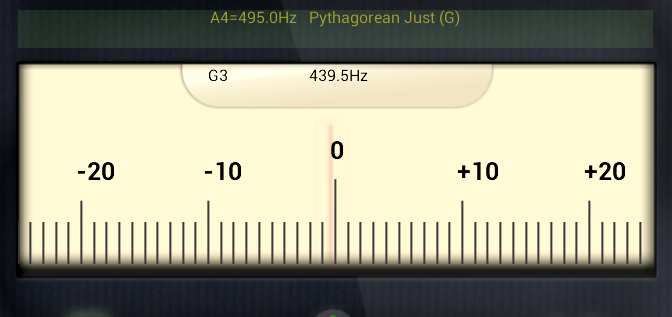Last night one of my gold strings popped. It was the f below na comhluighe, one of the original strings I put on the harp when it was brand new in 2007, half-hard 18 carat gold from Blundells in London.
Seeing as one of the higher gold strings had gone, I have taken the chance to redo the stringing and tuning. I took off the two gold strings above the one that went, and replaced all three with silver (the upper na comhluighe with one of my own dust-strings). And I tuned the harp to a new pitch standard of approximately A495/370.
The way this works is basically putting in two sharps and moving na comhluighe, and then conceptually relabelling all the strings, so what was previously A is now called G, etc.
I have been interested in the idea of higher pitch standards for the medieval Gaelic harps for some years. I always thought that pushing the harps to modern pitch while keeping the range I desired (the complete octave below na comhluighe g) was taking it a bit far; I always thought that they were a bit low-pitched but I didn’t want to lose a note in the lower octave and I never dared try a higher pitch standard. And then in the last year or two when I have considered daring a higher standard, my highest gold strings have been at their limit and wouldn’t allow me to tune them up.
There are so many variables, each affecting the others: the pitch standard, the name of the 29th string, and the metal you use in the treble, each affects the others. Each of these needs seriously dealt with to define the parameters for a potentially successful setup.
My current ‘student’setup has G/C on 29, brass trebles, and A=440/330. Of course 330 is far too low for sensible consideration so in real life we think of them as single-pitched instruments starting on G at a440. But I think the brass trebles are not sounding good because they are too low pitched. On my Queen Mary replica, for the past year or so I have had the same tuning / pitching but silver trebles, which works just fine.However, I am really thinking more and more that I want the 29th string to be not G/C – I want the ‘cronan’ G/C to be on no.28, so as to have one extra below.So my current setup has silver trebles, G/C on position 28, and A495/370. I feel this is now working well, it sounds good, it is practical in that it is a whole tone above ‘normal’ G pitch, though it is uncomfortably low for C pitch at a minor third below modern.Perhaps I should bite the bullet and go for brass trebles, G/C on 28, and A523/392. I have talked about this pitch standard a fair bit with Karen Loomis; she has tried it on her harp, and it works well. I also put an example schedule of it as well as references to discussions of it in ‘Early Music’ on my Tuning pages at EGHI. I find this tuning is a little high compared to ‘normal’ modern G tuning, at a minor 3rd high, but it is quite nice, a whole town down, compared to modern C tuning. This is an issue since hardly anyone is thinking of na comhluighe at c.Paul Dooley in his GSJ article suggests string 29 in the bass is “modern B” but I think that is pushing too far the other way. That would give a pitch standard, (if the lowest string is ‘cronan’ G/C), of A554/415. I don’t like this idea both because I think it is pushing the treble pitches a bit high for brass strings, plus it doesn’t give us the extra string below cronan G I want.
One final complication here. I like to muse on the medieval gamut which starts on “Gamma ut” G, an octave and a half below middle c. I used tho think it was no problem to put cronan G on the 29th string, and say that the harp started on Gamma ut. However that then clashes with my idea that na comhluighe might be on middle c, since I always put na comhluighe an octave above cronan G. (the reason for wanting na comluighe on c is because the shifting semitone, the 7th of the scale, is B natural / B flat in the medieval gamut, whereas it is F sharp / f natural in the 18th century Gaelic harp tunings which have na comhluighe on G).The double-standard system allows you to have na comhluighe g/c an octave above cronan G/C, but then if na comhluighe c is an octave above cronan C, where is Gamma Ut G? Answer, 3 notes below cronan C. It’s normal in Gaelic harp tuning to miss the note below cronan, so we need 2 strings below cronan to complete this scheme. So am I talking myself into a scheme where cronan G/C is string 27? Then the extra 30th string added to the Queen Mary and Trinity harps would complete the ‘renaissance’ complement of 3 strings below cronan, which I indicated on my 2012 tuning chart.
